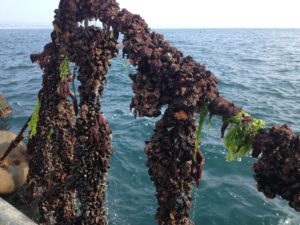
Author – Dr Ross Brown, Senior Research Fellow
HABs can result in the production of harmful algal biotoxins and oxygen depletion, therefore presenting a significant risk to shellfish and finfish health. According to the UK Marine Climate Change Impacts Partnership (MCCIP), HAB occurrences are anticipated to increase with climate change and the influx of warmer water planktonic algae, including more toxic species, to UK coastal waters, MCCIP Report Card 2013. The impacts of these HABs are likely to include prolonged closures of shellfish farms and increased mortality of juvenile fish on nursery grounds, and these are major future concerns for UK inshore wild fisheries and seafood farming (aquaculture).
‘Real-time’ monitoring via in situ sampling and ‘remote’ satellite sensing can readily detect high biomass and surface forming algal blooms, but these strategies provide limited forewarning and are not appropriate for detecting the onset of low biomass blooms (e.g. Dinophysis sp.) or blooms that initiate below the sea surface (e.g. Karenia mikimotoi). Another option is to use environmental data to predict where, when and how often such blooms are likely to occur. This information could then be used to inform mitigation strategies; allowing businesses to better plan the timing of shellfish harvesting, when and where not to feed finfish stock and furthermore, guide in the placement of new farms (i.e. locating new farms in areas that have a low risk of HABs forming).
Recent research undertaken in St Austell Bay by Drs Jamie Shutler and Wiebke Schmidt, at the University of Exeter, and Dr Peter Miller and colleagues from Plymouth Marine Laboratory (PML), has shown that the formation of HABs and the concentration of biotoxins in shellfish is associated with changes in environmental conditions, including sea surface temperature, solar radiation, rainfall and wind speed. Incorporating these factors in a site-specific predictive model enables one-week forecasts of biotoxin accumulation within the farmed shellfish. This work was been carried out as part of the UK Biotechnology and Biological Science Research Council (BBRSC) and UK National Environmental Research Council (NERC) funded ‘ShellEye’ project.
“Research studies such as AMHABs and ShellEye are key to informing and underpinning the sustainable development and management of marine ecosystem services, including capture fisheries and aquaculture (mariculture) …….,” – Dr Grant Stentiford, Centre for Environment, Fisheries and Aquaculture Science (Cefas) and Co-Director of Sustainable Aquaculture Futures (Cefas and University of Exeter partnership).
Researchers including Drs Ross Brown, Chris Lowe, Jamie Shutler and Prof Charles Tyler at the University of Exeter are currently working with PML colleagues to extend the modelling approach to identify what causes the formation of HABs, and importantly where they are likely to form, around entire coast of the UK South West Peninsula. This project ‘Assessing and Mitigating risks of Harmful Algal Blooms (AMHABs)’, has been funded by the European Maritime and Fisheries Fund (EMFF).


The findings of these research projects will help to inform decisions regarding Marine Spatial Planning in UK coastal waters and aid the development of strategies concerning adaptation to changing climatic and environmental conditions.
#ExeterMarine is a interdisciplinary group of marine related researchers with capabilities across the scientific, medical, engineering, humanities and social science fields. If you are interested in working with our researchers or students, contact Michael Hanley or visit our website!
